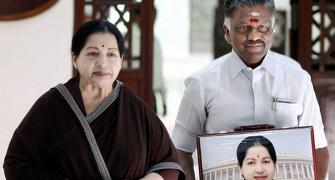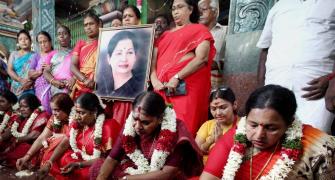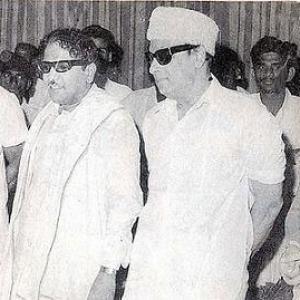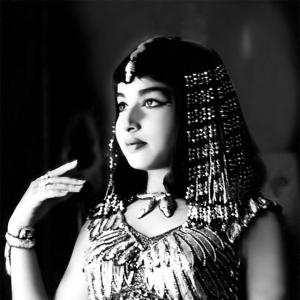Now that Tamil Nadu's tallest politician is no more, it remains to be seen how new political re-alignments could shape up, says N Sathiya Moorthy in the first of a two-part look at Jayalalithaa's life and politics.

Whatever she learnt or unlearnt from her political mentor and All India Anna Dravida Munnetra Kazhagam founder M G Ramachandran in politics, be in Tamil Nadu or at the national level, all of it only went to make Jayalalithaa Jayaram a steely self sturdier than even that of the former.
So much so, while MGR had a policy of accommodation, at times bordering on appeasement, in national politics, Jaya took her confrontationist politics all the way up to the top-most level, without fearing the consequences.
For a popular leader with a filmi past, anyone else in her place would have tried to build up a public image that would feed and lead her along her ambitious route to the nation's highest elected and most powerful office.
In her time, India had become a powerful nation in global reckoning, and the Indian prime minister has come to have a decisive say in world affairs than when she had begun her political career.
Yet, Jaya was not the one to yield, and would instead take a confrontationist approach to politics and policy-making at the national level if she was convinced that it was the only good thing for Tamil Nadu, and by extension, for her own political future.
That way, her political bête noire, DMK supremo Muthuvel Karnanidhi and his politician-son M K Stalin, along with a few others in their party, may have been the luckiest of all those that engaged in politics and/or political battles with Amma.
The DMK top leadership alone knew where exactly they stood vis-a-vis Tamil Nadu's most popular and ruthless ruler in the post-Independence era.
For all the political vitriole that she would pour over Karunanidhi -- she would call him 'evil' -- Jaya had a sly admiration for the man and the political machinery that he headed without a break since DMK founder C N Annadurai's death in September 1969.
'Mine is a party of defectors,' Jaya was known to have told a senior leader of a national party when they met over dinner in Delhi in the 1990s.
'MGR defected from the DMK to form the AIADMK, and had more defectors from Karunanidhi's side... That is still there in my party men,' she said, as if to explain her autocratic approach in running the party.
More importantly, MGR too had recognised that his was a party of defectors, and had instilled that sense in his political disciple too.
In context, Jaya had also reportedly praised Karunanidhi for running a more identifiable and organised political party when the late Odia leader Biju Patnaik made a second attempt to bring the two Dravidian majors together months before the 1996 general election.
Patnaik and George Fernandes, then Janata Party leaders, had made a similar failed attempt when MGR was around in the late 1970s.
Neither of the AIADMK chiefs would give in nor would Karunanidhi.
Each side was more afraid of the other devouring them politically and electorally after any merger, and sidelining their second line so very completely in a unified set-up.
Rather, the respective second line was afraid of being sidelined and torpedoed unity approaches at every turn.
All of it stopped after Stalin became a political force of his own, and Jaya more sure of herself.
Now, it remains to be seen how any new political re-alignment shapes up, especially after the 2016 assembly polls rendered Tamil Nadu a two-party state for all practical purposes.
In a way, MGR never contested any election without an ally.
Even when assertive about the DMK nearer home and unpredictable for his second-line -- a trait that he taught Jaya -- he was not unapproachable for political allies, and for party cadres even more.
With the Centre, especially, MGR would not want to take on the party in power.
More importantly, despite his strong views on regional issues such as the Cauvery waters (Mullapperiyar was still in the making) and the Sri Lanka ethnic issue, MGR saw himself as an Indian national first and wanted to be seen as such by the rest of the country.
MGR did not see himself as a pan-Tamil leader the way Karunanidhi had pictured himself, an image broken only by LTTE leader Velupillai Prabhakaran from across the Palk Strait.
With Prabhakaran gone -- or, even when he was around -- Jaya had taken to usurping that mantle, which sat comfortably on her shoulders after the decisive end to Sri Lanka's ethnic war in May 2009.
Jaya did not win the war-time parliamentary polls of 2009 even with better-known pan-Tamil allies like the MDMK's Vaiko -- who himself lost his Sivakasi seat -- as she may have hoped for.
Yet, from then on until her death, she had become the darling of pan-Tamil constituencies in and from across the world, whatever be the criticism levelled against her by lesser mortals of the same stock.
This may now have political consequences for the global pan-Tamil constituency, and politico-administrative challenges for whoever succeeds Jaya as Tamil Nadu chief minister -- O Panneerselvam today, anyone else tomorrow -- and by extension, for the Union of India, again, whoever the prime minister.
Given that a pan-Tamil concern, real or imaginary, is being flagged as much around the Kudamkulam nuclear power plant and the like as the Cauvery water and Mullaperiyar dam disputes, and the fishermen and ethnic issues involving Sri Lanka, this constituency may have been orphaned.
Successive prime ministers that Jaya had handled, first as a Rajya Sabha member, then as AIADMK faction leader, electoral ally and uncrowned queen of the party and the state, even if only up to a point, could have had only a bitter-sweet taste of her, nothing wholly bitter or excessively sweet.

Rajiv Gandhi, P V Narasimha Rao, Atal Bihari Vajpayee, Manmohan Singh and more recently Narendra Modi, did not know why Jaya was spreading her sweet political charms around them one day, and going hammer and tongs at them the very next day.
Jaya would align with Rajiv Gandhi and have the famous cup of tea with Sonia after his time, but in the parliamentary poll campaign later on would call the other woman, names.
She would dine with L K Advani in his home one evening, and years later would say in public that he was suffering from 'selective amnesia.'
Likewise, she would attend Narendra Modi's swearing in as Gujarat chief minister one day, but years later would tell her voters in election 2014, to choose between 'Modi and the Lady.'
To Jaya, political relationships did not necessarily matter. The less said about interim prime ministers like Chandra Shekhar, H D Deve Gowda and I K Gujral, the better. V P Singh did not exist for her.
In this, Deve Gowda's term could have helped to find an amicable answer to the vexatious Cauvery water dispute between Tamil Nadu and Karnataka -- first when he was chief minister, and later as prime minister.
Instead, Jaya's calculations were based almost entirely on retaining her core constituency back home in Tamil Nadu, and expanding it whenever and wherever possible.
Thus when Deve Gowda was CM, as his counterpart, she would stage an indefinite hunger strike for days together at the Marina beach in Chennai.
Be it the Cauvery or Mullaperiyar river water dispute with neighbouring Karnataka and Kerala respectively, the ethnic issue and the fishermen's problem across the Palk Strait with Sri Lanka, Jaya may not have been able to achieve much for her constituents in real term.
It was true of her predecessor DMK chief minister Karunanidhi too, whenever one had replaced the other at Fort St George, the seat of Tamil Nadu's politico-administrative power.
Her one-a-week, if not one-a-day, letters to the prime minister of the day on any or all of these issues may have irritated the powers-that-be in distant Delhi.
Yet, by refusing to let her acolyte ministers in the state to handle their portfolios, and herself indicating her disinterest in talking to anyone less than the prime minister of the country, Jaya did create a mental equation of herself in the minds of the officialdom in the national capital, the national media and counterpart chief ministers and other regional party leaders elsewhere too.
It was thus that when the Modi wave was sweeping across the rest of the nation in the 2014 parliamentary polls, Jaya stood her ground in Tamil Nadu, and trounced all rivals to take 38 of 40 Lok Sabha seats, including the lone Puducherry Union territory seat, in the region.
Jaya proved that for the nation's Tamil-speaking people and the region, the 'Lady' and not Modi mattered more.
This was at a time when no one anywhere in the country was talking about the possibilities of a post-poll Third Front government at the Centre or a short-term prime minister as in the mid-1990s.
Jaya's AIADMK second-line too had not projected and promoted her as prime minister in waiting in 2014 as they had done in the 1990s.
As the results showed, the nation's Tamil voters had taken to Amma as never before.
What followed in the assembly elections of 2016 was even more credit-worthy for the trust that Tamil Nadu's voters had put in her leadership.
For the first time since mentor MGR's passing, Jaya won two assembly elections in a row.
So what if the Opposition and sections of the media charged post-poll vote-count management, encouraged supposedly by Prime Minister Narendra Modi's advance call to greet Amma over her prospective victory when only a third or less of the votes had been counted, and AIADMK and DMK rivals were running neck-and-neck in many constituencies?
At the end of the day, not only did Jaya's leadership re-assert the AIADMK's single party supremacy over the state electorate for the second time since 2014, but the results showed that her pre-poll manoeuvring had converted Tamil Nadu into a two-party state all over again.

It's here that Jaya's exit will be sorely felt by her party, and more so sections of the non-DMK, and anti-Karunanidhi near-neutral electorate.
If her death meant Karunanidhi losing his comparative relevance that he had enjoyed since MGR splintered the DMK parent in 1972, his politician son M K Stalin could begin enjoying greater acceptance even outside the party than at present.
In the immediate course, there is nothing to suggest that the AIADMK will face any major upheaval, especially if the BJP-led Centre chooses to play neutral, unlike in some of the Congress-ruled states in the North and the North-East.
The BJP, whichmay want to wait until close to the 2019 parliamentary polls for a prospective alliance with the AIADMK, might still want to play favourites from within the ruling party in the state, but that again would depend on what moves subterranean factions within the party succeed in making between now and then.
In this, both the AIADMK and possibly the BJP leadership would have to constantly remember Karunanidhi's casual reference to the possibility of just 20 MLAs making the difference to who rules the state -- a one-time, less-publicised observation that he had made not very long after Jaya had become chief minister for the 6th time in May 2016.
For a convent-educated girl -- Bishop Cotton Girls' School, Bangalore, and Presentation Convent, Church Park, Chennai -- young Jaya should not be blamed for her looks or histrionic talents that made her stray from her passion for books and studies.
Mother Sandhya -- original name, Vedha, after whom Jaya would built her Poes Garden mansion in the upmarket area in the heart of Chennai -- was driven to filmdom despite being born into a family that had worked in the high echelons of the Mysore royal court.
Her first filmi appearance was for Epistle (1961) in English, and a few more appearances in Kannada and Telugu before then Tamil cinema's talent-spotter of the time, filmmaker C V Sridhar, would cast the young teenager as a near-equally young widow in his Vennira Aadai (White Attire, that was the traditional attire of women who had lost their husbands) in 1961.
It was then that MGR, looking for a young and fresh heroine to star with him after making a success of the careers of Anjali Devi, Banumathi and B Saroja Devi, spotted Jaya and teamed up with her in Aayirathil Oruvan, or One Man in a Thousand.
It was a hero-oriented period drama, but there was no going back for Jaya, be it in her film career or pairing wtih MGR, on screen and later on in politics, until her 100th film, Thirumangalyam (Mangalsutra, 1974) -- which she never got to wear in real life, having chosen to live single till the end -- bombed at the box-office after she had taken after her mother's ungainly figure while approaching middle age.
As if by coincidence, in her swan song of a film, Neenga Nalla Irukkonum (1992), released after she had become chief minister a year earlier, Jaya played a politician.
The title, meaning 'You should live long (for the benefit of the people)' had been borrowed from the lyrics for the MGR starrer, Idhayakkani (1975), loosely translated as 'apple of the eye,' which Jaya would become to AIADMK cadres after his time.
It is another matter that Jaya had sung a few film songs, not all of them as popular as her screen presence and song-and-dance sequences, and also cut a few devotional albums, none of which is known to the younger generation of her party cadres possibly.
Nor would they remember that Jaya had tried to write an autobiography of sorts for the popular Tamil magazine, Kumudam, and even tried for a journalist's job in a Chennai-based city magazine in English, now extinct.
Had she had continued on that path, maybe, Tamil Nadu politics, public administration and the AIADMK as a party might have been poorer for it.
This was also the time when MGR had moved onto other heroines like the late Manjula and Latha, but Idhayakkani had Hindi actress Radha Saluja pairing with him.
It is another matter that MGR had split away from the DMK in 1972, and was on way to becoming chief minister in the post-Emergency assembly elections in 1977.
There was no going back for MGR on the political front, so to say, until his death in 1987. Jaya herself, having identified with MGR until his fans began looking for fresher and younger heroines in his movies, had a mixed spell, pairing with thespian Sivaji Ganesan, as if by after thought, but more afterwards with second-rung heroes.
An unexpected fall in her career graph and the even more shocking death of her mother and mentor, Sandhya, when Vedha Nilayam was nearing completion, left Jaya reportedly distraught and desolate.
In between, she was rumoured to have married then Telugu superstar Sohan Babu, but it was never confirmed by either side.
After a gap of close to 10 years, MGR would return to Jaya's life, this time taking her under his political wing.
An ageing MGR, possibly astounded by his political popularity, as different from silver screen dominance at the box-office, could not afford to leave the AIADMK orphaned.
Though he still respected Karunanidhi for their days together in Tamil cinema and also in the DMK under its late founder C N Annadurai, MGR could not bring himself to letting his loyal cadres, to whom opposing Karunanidhi was the one-line mantra, without someone to lead them.
Jaya fitted the bill, as MGR seemed to have gauged her to be sharper than his other heroines, most of whom had settled down in life, were less ambitious and even more less hard working.
Jaya was soon made a Rajya Sabha member of the AIADMK where journalist and writer Khushwant Singh was among her admirers and guide in the Upper House of Parliament.
This also meant that Jaya would get the national-level political experience, exposure and contacts that MGR himself did not get before becoming chief minister.
MGR also made Jaya the party's propaganda secretary to give her the political and organisational space that a successor would require to operate and grow on her own -- even while he would still cut her to size from time to time, as MGR alone was known to be doing.
Yet for all the personal promotion that MGR did on her behalf, Jaya was made to feel orphaned, first when he came down with a stroke, and was admitted to Chennai's Apollo Hospitals before being flown to the US for treatment, and later after his death.
If Jaya admitted that she had felt like committing suicide on hearing of MGR's death, her detractors, more especially in the AIADMK, would not allow her physical space to travel with his body to the Marina sands where he would be buried.
As later day events would prove, Jaya learnt not only grit and determination, political acumen and personality promotion from MGR. She also developed a will to live, survive and succeed, as MGR did as he returned from the US to stay on in power until a relatively quiet death on Christmas eve, 1987.
It was thus that when the DMK returned to power in the 1989 assembly polls, after 13 long years of vanvas when MGR was chief minister, Jaya felt electorally defeated but became politically even more determined.
Even while unifying the AIADMK, after rival faction leader and MGR's widow, Janaki Ramachandran, one time actress herself, had lost out very badly in that election, Jaya might still have left active politics had it not been for one more of Karunanidhi's historic blunders, the likes of which had forced the creation of the AIADMK in the first place.
The leakage of a resignation letter from the state assembly, purported to have been written by Jayalalithaa, and recovered from the house of M Natarajan, in turn the husband of N Sasikala, who by now had become her confidante, meant that she would stay on to fight back, and overcome her circumstances.
This would be followed by an assembly ruckus in which senior DMK minister S Duraimurugan was alleged to have snapped at Jaya's sari pallu, possibly accidentally after she had reportedly advanced menacingly at Chief Minister Karunanidhi, and her hand aggressively waving in the air displaced his pair of spectacles from the nose bridge.
With a left eye wound, caused in a road accident years earlier and covered by a dark glasses, exposed without the dark glasses, Karunanidhi possibly looked hapless. That was enough for his second-line to become restless and listless.
The rest, as they say, is history. For the second time, the Centre dismissed the Karunanidhi government, though not immediately, nor over the Jaya issue.
While moving the motion for the purpose, then prime minister Chandra Shekhar would tell Parliament that it was over a 'national security issue,' possibly implying the DMK's linkages with the Tamil terror group, the LTTE.
Months later, Chandra Shekhar would be proved right when the LTTE assassinated Congress leader, Rajiv Gandhi, that too on Tamil Nadu soil, in Sriperumpudur, after media reports had indicated that he was poised to return as prime minister following Lok Sabha elections in the summer of 1991.
The rest was/is history, as the merged AIADMK under Jaya benefitted equally from the Congress alliance in the assembly polls of 1991.
The DMK was trounced, and almost all but Karunanidhi from among the DMK candidates lost the assembly polls, and also the Lok Sabha elections, that too by unprecedented margins.
N Sathiya Moorthy, veteran journalist and political analyst, is Director, Observer Research Foundation, Chennai Chapter.










